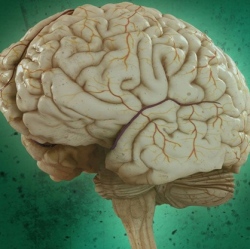
The Pentagon is attempting what was, until recently, an impossible technological feat, developing a high-bandwidth neural interface that would allow people to beam data from their minds to external devices and back. That’s right, a brain modem. One that could allow a soldier to, for example, control a drone with his mind.
This seemingly unlikely piece of technology has just gotten a lot less unlikely. The so-called “stentrode,” a combination stent and electrode, is the size of a paperclip and flexible. The tiny, injectable machine, the invention of neurologist Tom Oxley and his team at the University of Melbourne in Australia, could help researchers solve one of the most vexing problems with the brain modem: how to insert a transmitter into the brain without also drilling a hole in the user’s head, a risky procedure under any circumstances.
Based on existing stents that doctors use to clean blood vessels, the stentrode includes sensors and a tiny transmitter. Entering the bloodstream via a catheter, the stentrode swims in the bloodstream.
Doctors monitor the stentrode on its journey through the circulatory system. When the device reaches the brain, the physicians command it to expand against the blood vessels’ walls and hold station. There it remains for potentially months at a time, recording and relaying the subtle electrical signals that flow from the brain to the rest of the body.
“By reducing the need for invasive surgery, the stentrode may pave the way for more practical implementations of those kinds of life-changing applications of brain-machine interfaces,” Doug Weber, a DARPA program manager, said in a statement. According to DARPA, Oxley and his fellow researchers plan to test the stentrode on human patients as early as 2017 at the Royal Melbourne Hospital.
There are some dangers associated with the technology, Oxley told The Daily Beast. All stents run the risk of causing blood clots and strokes. But Oxley said that injecting the stentrode into a vein (which carries blood to the heart) rather than an artery (which carries blood from the heart) minimizes the stroke risk.
Even if the stentrode is fairly safe, it’s not clear that it will work the way the military wants it to. Oxley said he still doesn’t know whether the stentrode will be able to record the kind of fine data that DARPA would like its brain modem to handle.
Sensors resting directly on top of a brain during surgery have proved recently that they can detect neural activity at the level of a single brain cell. But a stent might not be able to achieve the same level of precision.
“Because it is located within the blood vessels of the brain, the stentrode will only be able to record electrical signals from large groups of brain cells,” says Bradley Greger, a neural engineer at Arizona State University.
But Oxley stressed that his stentrode is just a prototype. It should get better, he said. “The field of stenting is rapidly progressing.”
